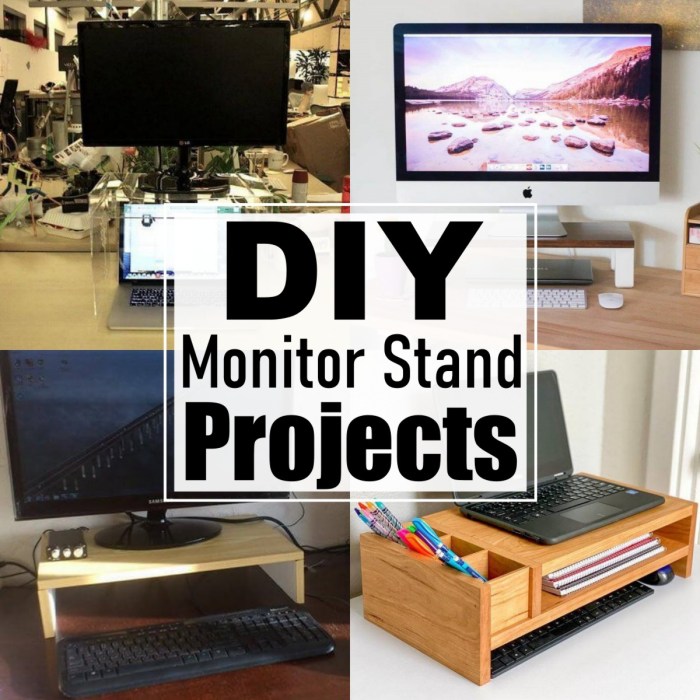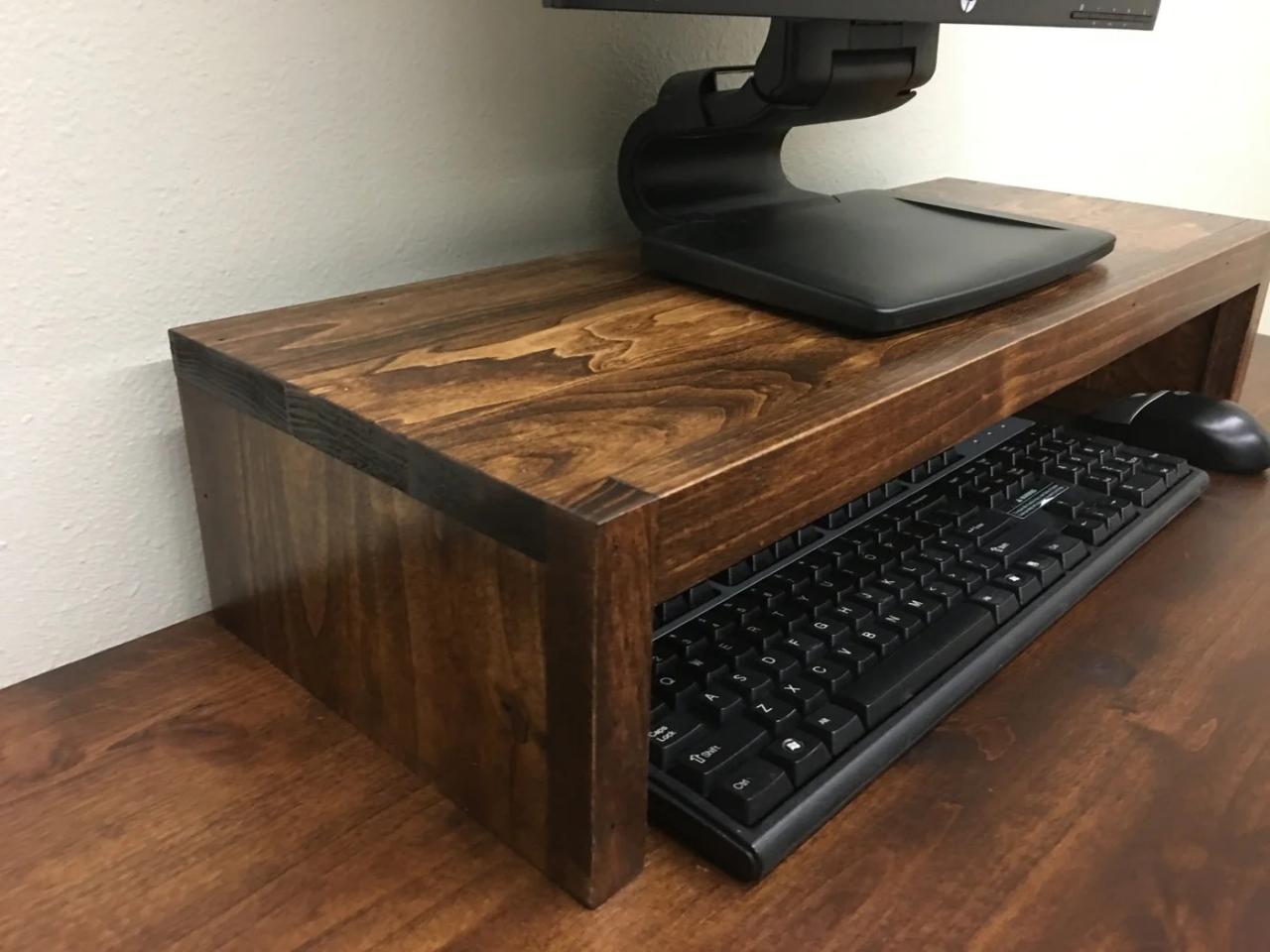DIY desktop monitor stand sets the stage for this enthralling narrative, offering readers a glimpse into a story that is rich in detail and brimming with originality from the outset.
Imagine a workspace that’s not only functional but also reflects your personal style. Building your own desktop monitor stand is a rewarding project that allows you to create a custom solution that meets your exact needs. From sleek and minimalist designs to intricate creations with built-in storage, the possibilities are endless. This guide will walk you through every step of the process, from planning and design to construction and customization.
Essential Tools and Materials: Diy Desktop Monitor Stand
Building a DIY monitor stand requires a set of basic tools and materials. Having the right tools and materials will ensure a smooth and successful project.
Tools
The tools required for this project are common and readily available.
- Measuring Tape: Essential for accurate measurements of the stand’s dimensions.
- Pencil: Used for marking the cutting lines on the wood.
- Saw: For cutting the wood to the desired size. A circular saw or a jigsaw is recommended for precision cuts.
- Drill: Necessary for drilling pilot holes and attaching the stand components.
- Screwdriver: For driving screws into the wood.
- Sandpaper: Used for smoothing out rough edges and creating a polished finish.
- Level: Ensures the stand is perfectly level, providing stability for the monitor.
- Clamps: Useful for holding wood pieces together while gluing or screwing them.
Materials, Diy desktop monitor stand
The choice of materials will depend on the desired style and functionality of the stand.
- Wood: The primary material for the stand. Consider using plywood, MDF, or solid wood like oak or pine, based on your preference and budget.
- Screws: Used for attaching the stand components. Select screws that are appropriate for the thickness of the wood and the weight of the monitor.
- Wood Glue: Provides a strong bond between the wood pieces. Opt for a high-quality wood glue that is specifically designed for woodworking.
- Finish: Optional, but recommended for protecting the wood and enhancing its appearance. You can choose from a variety of finishes, such as paint, stain, or varnish.
Safety Precautions
Safety is paramount when working with tools and materials.
- Wear Eye Protection: Always wear safety glasses to protect your eyes from flying debris.
- Use Gloves: Wear work gloves to protect your hands from splinters and sharp edges.
- Secure Work Area: Ensure a stable and clutter-free work area to prevent accidents.
- Proper Tool Usage: Always use tools as intended and follow manufacturer instructions.
- Handle Materials Carefully: Avoid dropping or mishandling heavy materials to prevent injuries.
Safety and Stability Considerations

A sturdy and stable monitor stand is crucial for a safe and comfortable workspace. A poorly designed stand can lead to monitor tipping, potential damage to your equipment, and even injury.
Therefore, you must prioritize stability and safety throughout the construction process. Consider these important factors:
Testing the Stand’s Strength and Stability
Testing the stand’s strength and stability is essential to ensure it can safely support your monitor. Here are some key methods to evaluate its robustness:
- Weight Test: Place the monitor on the stand and apply gentle pressure to the sides and top to check for any wobble or movement. If you notice any instability, you might need to reinforce the stand’s structure or adjust the base’s size.
- Stress Test: Simulate real-world conditions by applying a force to the monitor’s edge or pushing it slightly forward. Observe the stand’s reaction and look for any signs of bending, cracking, or instability. This will help you identify potential weak points and make necessary adjustments.
- Tilt Test: If your stand has a tilt function, test its stability in various tilt positions. Ensure the monitor stays securely in place without wobbling or tipping over. You can use a level to check for any tilt angle inconsistencies.
Preventing the Stand from Tipping Over or Collapsing
To prevent the stand from tipping over or collapsing, consider these preventive measures:
- Wide Base: A wider base provides greater stability, especially for heavier monitors. Ensure the base is large enough to distribute the weight evenly and prevent tipping. You can achieve this by using a wider piece of wood or adding weights to the base.
- Secure Mounting: If your stand is attached to a desk or wall, ensure the mounting points are strong and secure. Use high-quality screws and ensure they are screwed in deep enough to provide adequate support. If you are using a desk clamp, ensure it is securely attached and the clamp’s grip is strong enough to prevent the stand from sliding or tilting.
- Weight Distribution: Proper weight distribution is essential for stability. Ensure the monitor’s weight is evenly distributed across the stand’s base. Avoid placing heavy objects on the stand’s surface, as this could shift the center of gravity and increase the risk of tipping.
- Materials: Use strong and durable materials for your stand, such as hardwood or metal. Avoid using lightweight or flimsy materials that might not be able to withstand the monitor’s weight.
- Reinforcement: If you are concerned about the stand’s stability, consider reinforcing it with additional supports or braces. You can add cross-braces to the stand’s legs or use thicker wood for the base and support arms.
Alternative DIY Monitor Stand Projects
Beyond the classic wooden monitor stand, there’s a world of creative possibilities waiting to be explored. You can use readily available materials and techniques to craft unique and functional stands that perfectly suit your needs and style.
Monitor Stand from Recycled Materials
This section explores the benefits of repurposing materials for a monitor stand, highlighting the environmental and economic advantages of using recycled materials.
- Old Books: Stacking old books creates a unique and rustic stand. You can use different sizes and colors to create a visually appealing and functional stand.
- Wooden Pallets: Discarded wooden pallets can be transformed into sturdy and stylish monitor stands. They offer a rustic look and can be easily customized with paint or stain.
- Plastic Storage Bins: Turn an old plastic bin into a monitor stand by cutting a hole in the top for the monitor. It’s a quick and easy solution that can be easily cleaned.
Monitor Stand from Unexpected Materials
This section introduces unusual materials for crafting a monitor stand, promoting creative exploration and highlighting the unexpected versatility of everyday objects.
- PVC Pipes: PVC pipes are inexpensive and readily available, making them ideal for building a minimalist and modern stand. You can connect different pipe sizes to create a customized stand.
- Metal Pipes: Metal pipes offer a more industrial and robust look. You can use them to build a stand with a unique and eye-catching design.
- Lego Bricks: Lego bricks can be used to create a playful and personalized monitor stand. You can build a stand with various shapes and colors to match your desk setup.
Resources and Inspiration

The internet is a treasure trove of DIY resources and inspiration, especially when it comes to projects like building a monitor stand. You’ll find countless tutorials, plans, and communities dedicated to helping you create your perfect stand.
Online Resources and Communities
There are many online resources that can provide you with inspiration and tutorials for DIY monitor stands. These resources offer a wealth of information, from basic design ideas to detailed step-by-step instructions.
- YouTube: YouTube is a great place to find DIY video tutorials. Search for “DIY monitor stand” or “monitor stand build” to find a variety of videos, from simple to complex. Many creators provide detailed instructions and tips for building different types of stands.
- Pinterest: Pinterest is a visual platform where you can find inspiration for all sorts of DIY projects, including monitor stands. You can browse through thousands of images and find ideas for designs, materials, and finishes.
- Reddit: Reddit has several communities dedicated to DIY projects, such as r/DIY and r/woodworking. These communities are a great place to ask questions, share your projects, and get feedback from other DIY enthusiasts.
- Instructables: Instructables is a website that features a vast collection of DIY projects, including monitor stands. You can find step-by-step instructions, photos, and user reviews for a variety of projects.
- Blogs and Websites: There are many blogs and websites dedicated to DIY projects and woodworking. These websites often feature articles, tutorials, and plans for building monitor stands and other furniture.
With a little creativity and effort, you can transform your workspace with a DIY monitor stand that enhances both functionality and aesthetics. Whether you’re a seasoned DIY enthusiast or a beginner looking for a fun and challenging project, this guide provides everything you need to get started. So, gather your tools, choose your materials, and embark on a journey of self-expression and ergonomic improvement. Your workspace awaits a personalized touch.
A DIY desktop monitor stand can be a great way to improve your workspace ergonomics and reduce eye strain. While you’re focusing on your posture, it’s also important to consider your overall health. If you’re struggling with type 2 diabetes, you might want to talk to your doctor about Trajenta 5 mg , a medication that can help regulate blood sugar levels.
Once you’ve got your health in check, you can focus on finishing that monitor stand and creating a more comfortable and productive workspace.
